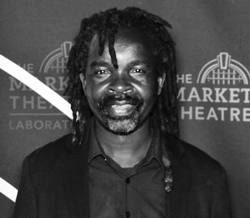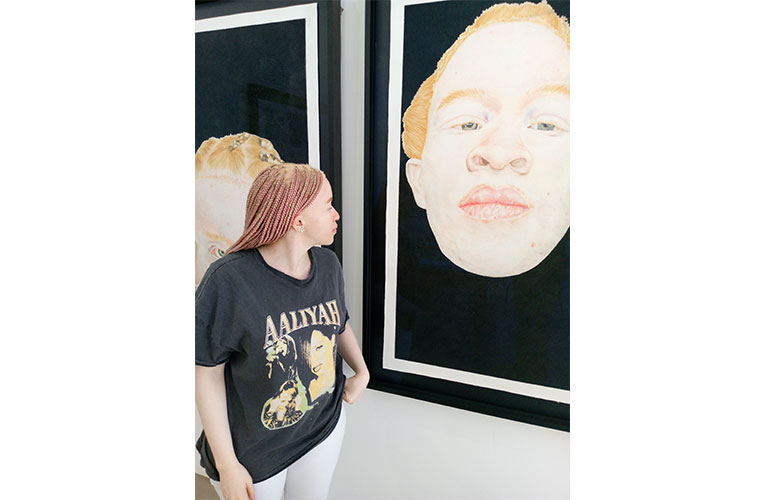Artist Athenkosi Kwinana’s passion for creating new narratives about people living with albinism
By Edward Tsumele, CITYLIFE/ARTS Editor

About four years ago, after attending a show that was about the life people that live with albinism experience, especially the attitudes and misplaced belief systems in African societies, I found myself close to tears. This is not because I cannot handle heavy stuff on stages. The fact is in my life as an arts critic and theatre writer I have indeed viewed artworks on walls that deal with the dark side of life. And similarly I have watched plays on theatre stages depicting similar life experiences, a portrayal of human weakness. I found myself as fate would have it, experiencing the same feeling a year after this in another theatre, and this time at Joburg Theatre.
The first time I saw Mama I want the Black You Are created by the son and father team of Mpho Molepo and Arthur Molepo, well-known actors on both the small screen and stage, it was at the State Theatre in Pretoria. I have since followed closely the story of the lives of people who live with albinism with keen interest.
And that is why two weeks ago, I immediately got interested in the art practice of visual artist and researcher Athenkosi Kwinana, who I met at223 Jan Smuts Creative Hub, Rosebank, Johannesburg, a space which among other art initiatives houses Berman Contemporary and The Creatory, an Art Lab. That was where I found Kwinana, where she is currently an artist in residency, working on her latest body of work, which focuses on the lives and times of people who live with albinism.
She herself lives with albinism and therefore in her art practice, she focuses on this condition, portraying the lives of people with this condition that often affects the quality of their ability to see and their skin as well. Kwinana, who has researched the subject in her entire academic career, from undergraduate level up to a Masters level, writing a thesis on the subject for her Masters degree in Fine Art that she completed at the University of Johannesburg in 2022, Kwinana is therefore able to fuse social activism, art making and academic rigour into her art practice. This positions the artist on a trajectory that makes her one of the few artists who are in a position to articulate and visually represent people living with this condition in the country.

“I have done a great deal of research on the subject, starting from the time when I did my Under Grad degree at Walter Sisulu University in the Eastern Cape. For my B-tech in Fine art, I researched the lives of people living with albinism in the Eastern Cape where I was born. (She hails from Mthatha). I found out that they are not well represented in the mainstream. I was encouraged to do this by one of my lecturers, who suggested that I do research about the lives of people living with albinism.
“Kwinana told me in an interview while she was working in the space occupied by the Creatory in this new art space in Johannesburg, which opened this year with a huge launch that involved a group exhibition, live music performances, wine and food offered to guests, marking 223 Jan Smuts Creative Hub, one of the most significant art spaces on the Johannesburg contemporary art scene.
“I completed a Master of Fine Art (MFA) degree at the University of Johannesburg in 2022, and my thesis is on the visual representation of people living with albinism. What I found out is that people with albinism are under-represented in visual narratives, and when there is an attempt to represent them, the narrative turns out to be disappointing. This is because artists who try to represent people living with albinism in their art practice, are themselves not well informed, and therefore unfortunately resulting in misrepresentation,” Kwinana pointed out.
What Kwinana is getting at is not to say that those that try to represent people living with albinism, deliberately misrepresent them, but that they tend to be not well versed in the subject matter mainly due to a lack of research and existing societal stereotype that tend to be reproduced in the visual narratives produced by the artists.
“Not much research and written material is available about the subject. The little that is there are books written by academics who are not from Africa themselves” she points out.
The artists said that besides the harmful traditional belief systems on the African continent, often putting people living with albinism in danger, such as muthi killings for people living with albinism that often take place in society, there are also irritating societal stereotypes assigned to people living with albinism.
“For example, young people of my generation tend to be more accepting and understanding when it comes to people living with albinism, but the older generation is less accepting. But even among the young people who are accepting, you will find certain behaviour though not harmful, but irritating. An example is when you get to date someone, and you ask them whether they are prepared for what will happen. At the beginning they will say yes, maybe because at that time, they are still smitten, but a few months down, they get easily irritated by people staring at you as you walk in the streets,” she explained. This often puts a strain on the couple’s relationship, Kwinana revealed.

As I spoke to her, Kwinana was busy working on portraits of models living with albinism.
“This one is a portrait of someone who is white and lives with albinism. This one is of a model who is black and is living with albinism, and the other one is that of a model who is Indian and lives with albinism.” She said pointing at the work in progress spread over the table in the studio. This series will form part of her solo exhibition that will take place at Berman Contemporary in September, 2024 as part of her current residency at The Creatory.
I immediately also noticed two sets of self-portraits, one set of four pictures hanging on the Eastern walls of The Creatory and another two sets of self-portraits on the northern walls of the studio. I remark that looking at those portraits reminded me of the work of internationally renowned South African photographer Zanele Muholi, who has the distinction of having put on the world map the visibility of lesbians, ironically just like the life of people living with albinism, also face similar issues of existential threats in the hands of a society that does not seem to understand the co-existence of diversity with the so called normalcy in creation. It is a society that simply refuses to accept differences.
“Zanele Muholi has done quite a lot with regards to elevating the visibility of theLGBTQ+ community. In many ways, people living with albinism face the same threats of physical harm, and therefore there is a need to elevate the visual narratives of people living with albinism in society. My work is an attempt to do exactly that. In fact these portraits were very much inspired by the self-portraits of Zanele Muholi in as far as their confrontational posture is concerned. As a viewer or audience, you simply cannot avoid the gaze. These portraits invite you to engage with the subject matter. It is intentional on my part,” Kwinana said as we concluded the interview.
But before I left, Kwinana shared with me the unique challenges that people who live with albinism, such as she who lives with type 2 albinism, which affect her eyes, making her struggle to paint without good quality glasses for example.
“This space, The Creatory is quite a relief for me because the lighting coming from outside is good for me. As someone who lives with albinism and who is a visual artist, I need good lighting, and timing as to when do I draw is everything. I have to work at certain times when the light is good as I need to be in a position to determine for example precise colour co-ordination,” she explained. It was only then that I fully understood the extra challenges of visual artists living with albinism who are practicing artists.
As I made my way out of The Creatory and out of 223 Jan Smuts Creative Hub, the scene on stage when I watched Mama I want the Black you Are, haunted me again as it replayed in my mind. But, with my mind bringing me back to Kwinana’s inspirational story of making those invisible visible, those muted loud and those existing on the margins coming towards the mainstream through her pencil, lifted my spirits again. Kwinana is indeed an artist to watch out for. Very soon.










